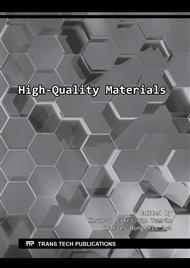[1]
Rahman, Z. A., Lee, J. Y. Y., Rahim, S. A., Lihan, T., & Idris, W. M. R. Application of Gypsum and Fly Ash as Additives in Stabilization of Tropical Peat Soil. Journal of Applied Sciences 15(7) (2015) 1006–1012.
DOI: 10.3923/jas.2015.1006.1012
Google Scholar
[2]
Zainorabidin, A., & Wijeyesekera, D. Geotechnical Challenges with Malaysian Peat. Proceedings of the Advances in Computing and Technology 2nd Annual Conference University of East London, UK (2007).
Google Scholar
[3]
Sa'don, N. M., Abdul Karim, A. R., Taib, S. N. L., & Yusof, M. Strength Properties of Reinforced Peat Using Fibre-Polyester and Shredded Rubber-Crumb as Reinforcement Material. International Journal of Engineering & Technology 7 (2018) 26–30.
DOI: 10.14419/ijet.v7i3.18.16667
Google Scholar
[4]
Sa'don, N. M., Abdul Karim, A. R., Jaol, W., & Wan Lili, W. H. Sarawak Peat Characteristics and Heat Treatment. UNIMAS E-Journal of Civil Engineering Sarawak 6–12 (2015).
DOI: 10.33736/jcest.139.2014
Google Scholar
[5]
Raghunandan, M. E., & Sriraam, A. S. An overview of the basic engineering properties of Malaysian peats. Geoderma Regional 11 (2017) 1–7.
DOI: 10.1016/j.geodrs.2017.08.003
Google Scholar
[6]
Huat, B.B. ., Kazemian, S., Prasad, A., & Barghchi, M. State of an art review of peat: General perspective. International Journal of the Physical Sciences 6(8) (2011) 1988–(1996).
Google Scholar
[7]
Michelin. Tire Manufacturing | How A Tire Is Made | Michelin US. https://www.michelinman.com/US/ en/help/how-is-a-tire-made.html (2017).
Google Scholar
[8]
Jia, N., & Kagan, V. A. Mechanical Performance of Polyamides with Influence of Moisture and Temperature – Accurate Evaluation and Better Understanding. Plastics Failure Analysis and Prevention (2001) 95–104.
DOI: 10.1016/b978-188420792-1.50014-7
Google Scholar
[9]
Kolay, P., Aminur, M. R., Taib, S. N. L., & Mohd Zain, M. I. S. Stabilization of Tropical Peat Soil from Sarawak with Different Stabilizing Agents. Geotechnical and Geological Engineering 29(6) (2011) 1135–1141.
DOI: 10.1007/s10706-011-9441-x
Google Scholar
[10]
Mesri, G., & Ajlouni, M. Engineering Properties of Fibrous Peats. Journal of Geotechnical and Geoenvironmental Engineering 133(4) (2007) 349–359.
DOI: 10.1061/(asce)1090-0241(2007)133:7(850)
Google Scholar
[11]
Teong, I.T., & Ngee, F.L.L. Geochemical Properties of Peat Soil in Sarawak - A Review. Applied Mechanics and Materials 773 (2015) 1417–1421.
DOI: 10.4028/www.scientific.net/amm.773-774.1417
Google Scholar
[12]
Elbagermi, M., Hamoda, W., Ben-Hmida, E., & Edwards, H. Quality Assessment of the Various Brands of Portland Cement Available in the Libyan Market. J. Mater. Environ. Sci 10(12) (2019) 12.
Google Scholar
[13]
Lawry, J., Ray, A., Klimesch, D., Thomas, P., Guerbois, J. P., & Harrison, J. Thermal characterization of portland cement-magnesia blends. Journal of Thermal Analysis and Calorimetry 80(3) (2005) 637–641.
DOI: 10.1007/s10973-005-0706-6
Google Scholar
[14]
Borsoi, A., Collepardi, S., Coppola, L., Troli, R., & Collepardi, M. Effect of Superplasticizer Type on Performance of High-Volume Fly Ash Concrete. Aci Special 195 (2000) 17–28.
DOI: 10.14359/9902
Google Scholar
[15]
Ropp, R. C. Group 16 (O, S, Se, Te) Alkaline Earth Compounds. In: Ropp, RC. (Ed.) Encyclopedia of the Alkaline Earth Compounds. Elsevier, Amsterdam, The Netherlands, (2013).
DOI: 10.1016/b978-0-444-59550-8.00003-x
Google Scholar
[16]
Burghaus, U. Surface science studies of carbon dioxide chemistry. New and future developments in catalysis. Elsevier, Amsterdam, 2013, Pp.27-47.
DOI: 10.1016/b978-0-444-53882-6.00003-6
Google Scholar
[17]
Tremblay, H., Duchesne, J., Locat, J., & Leroueil, S. Influence of the nature of organic compounds on fine soil stabilization with cement. Canadian Geotechnical Journal 39(3) (2002) 535–546.
DOI: 10.1139/t02-002
Google Scholar
[18]
Saberian, M., & Rahgozar, M. A. Geotechnical properties of peat soil stabilised with shredded waste tyre chips in combination with gypsum, lime or cement. Mires and Peat 18 (2016) 1–16.
Google Scholar
[19]
Sutter, L. Comparison of Class C Versus Class F Fly Ash for Concrete Pavement. 0092 (2015).
Google Scholar
[20]
Tang, C. S., Shi, B., & Zhao, L. Z. Interfacial shear strength of fibre reinforced soil. Geotextiles and Geomembranes 28(1) (2010) 54–62.
DOI: 10.1016/j.geotexmem.2009.10.001
Google Scholar


